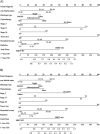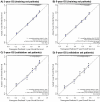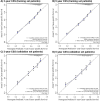Construction and validation of nomograms for predicting overall survival and cause-specific survival in cervical cancer patients undergoing radical radiotherapy based on the SEER database
- PMID: 40365497
- PMCID: PMC12069064
- DOI: 10.3389/fmed.2025.1587465
Construction and validation of nomograms for predicting overall survival and cause-specific survival in cervical cancer patients undergoing radical radiotherapy based on the SEER database
Abstract
Objective: This study aimed to construct and validate competitive-risk model nomograms using the Surveillance, Epidemiology, and End Results (SEER) database to predict the overall survival (OS) and cause-specific survival (CSS) for cervical cancer patients treated with radical radiotherapy from 2000 to 2020.
Materials: Cervical cancer cases treated with radical radiotherapy in the SEER database were retrieved. Inclusion criteria included the pathological diagnosis of cervical cancer, diagnosis within the specified time frame, and age between 20 and 79 years. Exclusion criteria were the presence of other malignant tumors, cancer-directed surgery, and incomplete data. Variables such as age, diagnosis year, and race were extracted. Patients were randomly divided into a training set and a validation set at a 4:1 ratio using a stratified random sampling method. For the training set patients, univariate and multivariate Cox regression analyses were performed, and CRM nomograms to predict the 3-year and 5-year OS and CSS were created in R. Harrell's concordance index (C-index) and a calibration curve were used to assess model performance.
Results: A total of 8,810 patients were included for OS and CSS analysis. The median follow-up was 26 months. The median OS was 64.0 months and CSS was 135.0 months. Diagnosis year, marital status, histologic type, chemotherapy, T stage, N stage, M stage, tumor size, median household income, and radiation modality were factors influencing the median survival time of OS and CSS. Age was an independent factor influencing OS. The C-index for OS and CSS predictions were 0.72 [95% confidence intervals (CI), 0.70 to 0.74] and 0.73 (95% CI, 0.71 to 0.75), respectively. Calibration plots showed good agreement between nomogram predictions and actual observations.
Conclusion: The nomograms can objectively and precisely predict the OS and CSS of cervical cancer patients receiving radical radiotherapy.
Keywords: SEER database; cause-specific survival; cervical cancer; overall survival; radical radiotherapy.
Copyright © 2025 Zhang, Rong, Jiang, Mu and Zhao.
Conflict of interest statement
The authors declare that the research was conducted in the absence of any commercial or financial relationships that could be construed as a potential conflict of interest.
Figures



Similar articles
-
Nomograms predicting the overall survival and cancer-specific survival of patients with stage IIIC1 cervical cancer.BMC Cancer. 2021 Apr 23;21(1):450. doi: 10.1186/s12885-021-08209-5. BMC Cancer. 2021. PMID: 33892663 Free PMC article.
-
[Development and Evaluation of Prognostic Nomogram Model for Adult Ventricle Glioma Patients].Sichuan Da Xue Xue Bao Yi Xue Ban. 2022 Jul;53(4):588-596. doi: 10.12182/20220760203. Sichuan Da Xue Xue Bao Yi Xue Ban. 2022. PMID: 35871728 Free PMC article. Clinical Trial. Chinese.
-
Identifying the Prognosis Factors and Predicting the Survival Probability in Patients with Non-Metastatic Chondrosarcoma from the SEER Database.Orthop Surg. 2019 Oct;11(5):801-810. doi: 10.1111/os.12521. Orthop Surg. 2019. PMID: 31663279 Free PMC article.
-
Prognostic models for predicting overall and cancer-specific survival of patients with initially diagnosed metastatic cervical squamous cell carcinoma: A study based on SEER database.Medicine (Baltimore). 2023 Jul 14;102(28):e34313. doi: 10.1097/MD.0000000000034313. Medicine (Baltimore). 2023. PMID: 37443499 Free PMC article.
-
Analysis of prognostic factors of metastatic endometrial cancer based on surveillance, epidemiology, and end results database.Front Surg. 2023 Jan 6;9:1001791. doi: 10.3389/fsurg.2022.1001791. eCollection 2022. Front Surg. 2023. PMID: 36684133 Free PMC article. Review.
References
-
- Corrado G, Anchora LP, Bruni S, Sperduti I, Certelli C, Chiofalo B, et al. . Patterns of recurrence in FIGO stage IB1-IB2 cervical cancer: comparison between minimally invasive and abdominal radical hysterectomy. Eur J Surg Oncol. (2023) 49:107047. doi: 10.1016/j.ejso.2023.107047, PMID: - DOI - PubMed
-
- Bogani G, Scambia G, Fagotti A, Fanfani F, Ciavattini A, Sopracordevole F, et al. . Sentinel node mapping, sentinel node mapping plus back-up lymphadenectomy, and lymphadenectomy in early-sTage cERvical caNcer scheduled for fertilItY-sparing approach: the ETERNITY project. Eur J Surg Oncol. (2024) 50:108467. doi: 10.1016/j.ejso.2024.108467, PMID: - DOI - PubMed
-
- Pötter R, Tanderup K, Schmid MP, Jürgenliemk-Schulz I, Haie-Meder C, Fokdal LU, et al. . MRI-guided adaptive brachytherapy in locally advanced cervical cancer (EMBRACE-I): a multicentre prospective cohort study. Lancet Oncol. (2021) 22:538–47. doi: 10.1016/s1470-2045(20)30753-1, PMID: - DOI - PubMed
LinkOut - more resources
Full Text Sources

